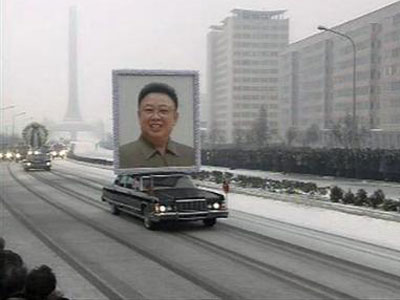Kim Jong-un, the designated successor to the dynastic power in Pyongyang, North Korea, bid farewell on Wednesday to his deceased father, Kim Jong-il, walking along his hearse through snow-covered downtown Pyongyang in an extensive funeral closely watched for early glimpses of who’s rising and who’s fading under the young untested leader, The New York Times reports.
Neat rows of soldiers stood bowing in front of the Kumsusan mausoleum, where Kim Jong-il’s body had been lying in state since his death was announced on Dec. 19.
When the funeral motorcade stopped before them, they gave a last salute, and then a military band played the national anthem. As the motorcade crawled through Pyongyang under a cold, gray sky, wailing crowds of citizens and soldiers lined the route, beating their chests according to the North’s Central TV footage.
A car with a large portrait of a beaming Kim Jong-il on its roof led the motorcade, followed by the hearse bearing his coffin draped with a red flag. A phalanx of soldiers carrying various party and military flags followed.
Kim Jong-il, who suffered a stroke in 2008, died of a heart attack on Dec. 17, according to the North Korean announcement. He left behind a country gripped by chronic food shortages but armed with nuclear weapons and a dynastic successor in his 20s whose control on military generals and party secretaries remains a subject of intense speculation among outside analysts.
The lineup of party and military officials at the state funeral gave the North Koreans and the rest of the world a first official look on who was leading North Korea during its critical transition of power.
And it unveiled no surprise face; the lineup was the same mix the outside world has seen in the past several months: stalwarts from the days of Kim Jong-il and his father, the North’s founding president, Kim Il-sung, and those who expanded their influence while playing crucial roles in grooming the son as successor under the father’s tutelage.
The list appeared to reflect the regime’s emphasis on an orderly transition. Dubbing Mr. Kim the “great successor,” North Korea’s state-run media have stressed in the past week that he would inherit his father’s songun, or “military-first,” policy.
In the past week, the regime has moved briskly to rally the key agencies of power behind Mr. Kim. When he visited his father at the Kumsusan mausoleum for the fifth time on Tuesday, the North Korean media referred to him as the “sagacious leader of our party, state and military.”
The funeral and massive mourning appeared to have been meticulously choreographed by the regime to boost the cult of personality that underpinned the Kim family’s dynastic rule. As citizens wailed on the freezing streets, state TV and radio announcers exhorted North Koreans to uphold the Kim family with their lives. They even attributed the heavy snow fall ahead of the funeral to the “heaven’s grief” over Kim Jong-il’s death.
On Wednesday, Rodong Sinmun, the main newspaper of the Workers’ Party, called the North’s nuclear weapons and long-range missile technology among the biggest achievements of Kim Jong-il. “Thanks to these legacies, we do not worry about the destiny of ourselves and posterity at this time of national mourning,” it said.
 Epress.am News from Armenia
Epress.am News from Armenia

